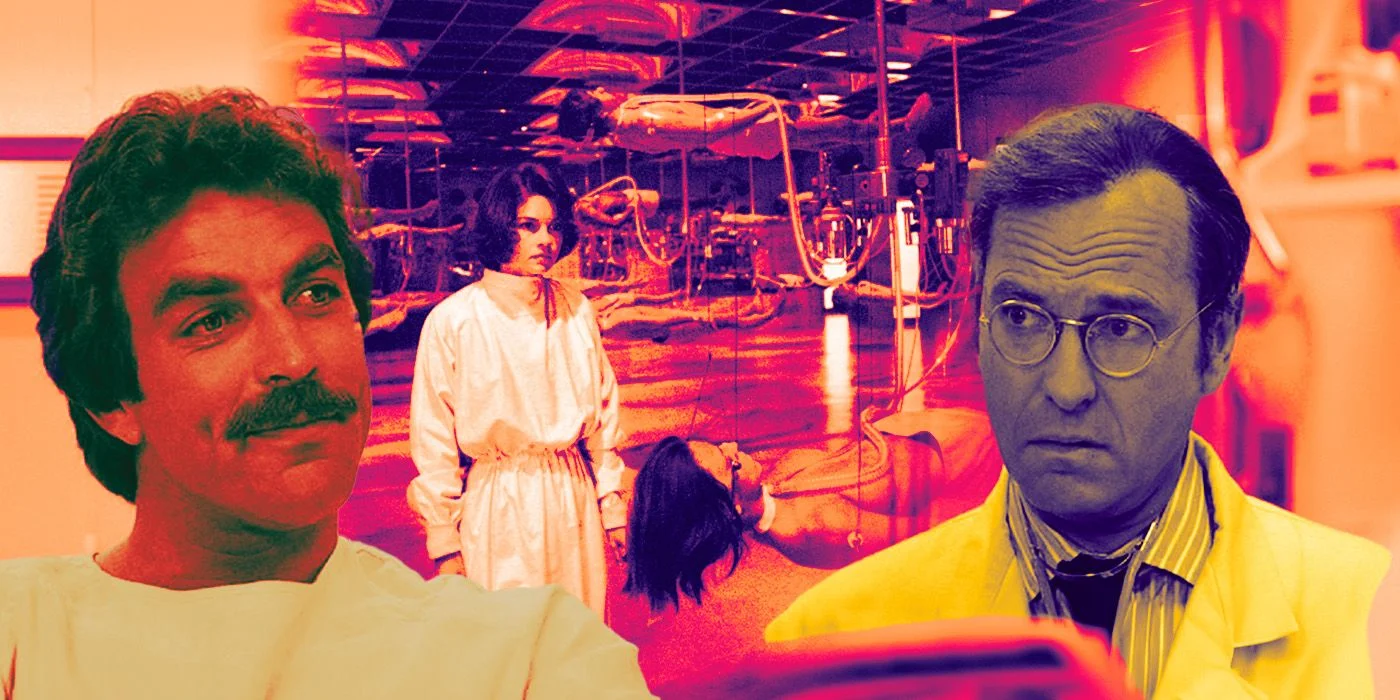How Coma Created Controversy for Decades

Be warned, the following article contains minor plot spoilers for the film Coma
Summary
- Coma
used the fear and uncertainty surrounding illness and hospitals to create a medical thriller with a unique and unsettling premise. - The film accurately depicted the potential causes and complications of being in a coma, unlike other movies. However, it angered some doctors.
- Coma
negatively portrayed the medical industry, causing panic and a decline in organ donations after its release.
You don’t need much to make a visit to the hospital nerve-racking. Upping the drama from mere anxiety to absolute moral panic, director and writer Michael Crichton would use that innate unease when making his hospital-themed movie Coma, a mostly forgotten but jarring thriller from 1978. Depending on who’s watching it, the slow-burning horror film is either an eye-opening exposé on the dangers of the medical industry run amok or a dangerous piece of trash that ruined the reputation of science for nothing but the sake of selling tickets.
Starring Geneviève Bujold, Michael Douglas, and Richard Widmark, the film would notably feature a screenplay written and directed by the fertile mind who came up with the Jurassic Park and West World ideas. Releasing during the beginning of the slasher genre, this would be a novel horror premise of a whole new variety, focusing on the medical dilemma of how to deal with the comatose. Instead of fixating on psychos with knives, it would cast its villains as surgeons and hospital administrators, bypassing the schlock and cutting directly to people’s dread of helplessness when it comes to going under the knife.
The film lacks any kind of allegory or complex character study. Coma warned against the abuse of science, commenting on how the American medical industry is, first and foremost, a business. In the back of the mind of everyone who enters a hospital for “routine surgery” lies much intimidation and insecurity, but until novelist Robin Cook and Crichton came along, no one had played on those feelings so effectively. It worked like a charm, probably too well. The complications from the film’s depictions of the inner workings of the organ transplant world would take decades to alleviate.
Most Filmmakers Don’t Understand Basic Biology
A quick survey of the depictions of comas in movies like Kill Bill and you notice a trend emerging. No one really knows or cares about medical science. Out of all the preposterous elements in Alien, the fact that the crew of the Nostromo walked out of “hypersleep” without showing the slightest effect of being inanimate for months or years is the least believable. The sequel trumped it for pure silliness, the space marines chomping cigars and doing pull-ups within minutes of waking.
Being confined to a bed for more than three weeks comes with a litany of potentially life-threatening side effects not limited to atrophied muscles, brain damage, blood clots, and damaged respiratory and digestive organs that require months to restore through rehab. We could go into far more detail, but feel free to delve into that harrowing topic on your own.
No film or TV show generally understood the fine points until director Michael Crichton came along. Leatherface chasing you down a dirt road in Texas is scary only in a hypothetical sense, but the idea of a Harvard-trained anesthesiologist inducing a coma to steal and auction off your left kidney provokes a unique gut reaction. The central premise muddies the facts regarding organ and tissue donation. There is, in fact, a body trade, though it is reserved for the deceased, not those in comas, and this distinction is very important. However, if the film got under the skin of everyone who watched it, there’s one undeniable reason why. The realistic horror was hard to watch. Nobody wants to know what happens after a person dies, nor do we want to dwell on death, let alone the financial side of processing bodies. That wasn’t an accident.

8 Medical TV Dramas That Are Highly Inaccurate (But Otherwise Entertaining)
Despite the undeniable entertainment factor behind many shows, the accuracy of medical dramas is the center of on-and-offline debates for decades.
Coma Focused on a Lingering Medical Debate
Both the director/screenwriter and novelist (Robin Cook) were trained doctors, first crossing paths before either one had changed careers and went Hollywood. Cook, a prolific writer in his own right, would come to specialize in the bioethical/medical-thriller genre, carving out his own niche not unlike John Gresham did for lawyers.
The 1977 bestseller Coma enthralled readers with a different kind of conspiracy while keeping the damsel in distress plot intact. In a curious twist, this would single the writers out for more ridicule than had they merely been John Carpenter or Alfred Hitchcock spinning a creepy yarn. At the core of the story is a lingering medical debate concerning “brain death” and what constitutes an “irreversible coma,” a conundrum that only doctors can fully comprehend. Luckily, this film had two. Rather than waste time on that point, the movie wisely shows the practical consequences of a hospital having too much authority over patients.
While filmmakers like David Cronenberg cover similar narratives of corporate-medical shenanigans, Coma stuck out because it was so realistic in its approach, less hung up on gross-out body horror than a kind of existential dread. In Coma, you are a consumer and a product, in precisely that order. You can laugh off a Cronenberg movie with all its brooding telepathic megalomaniacs, rabies-infected porn stars, mutant children, and science babble, but Crichton’s depiction of evil scientists is a nastier kind of horror specifically because it is so plausible.
High-tech computers handle billing, while everyone talks in a flat speech pattern as they mince a brain into sections. It’s all the more startling because the filmmakers seem to have done their homework, unafraid to talk over our heads. As if assuming the people watching already understand how oxygen deprivation affects the brain or the inherent complications of anesthesia, Cook and Crichton go out of their way to show the baddies constructing a (somewhat) believable treatment program to reduce infection and bed sores and reduce staffing. This is all in an attempt to show the cost-saving benefits of the operation to investors as they walk around sterile aisles of “stored” brain-dead victims, their patients more or less held hostage. As effective as Cronenberg was as a director, Crichton’s emotionless exposition dump may be more disturbing than any set piece Cronenberg made in his whole career.

The ’70s Canadian Horror Boom (and Bust), Explained
The Canadian government opened up their wallets anticipating The Sound of Music. Instead, they got exploding heads and deformed, murderous babies.
Coma Caused Plenty of Paranoia
Thanks to Crichton, the negative portrayal created many myths that medical experts have spent the better part of the last half-century living down. Laws – at least pertaining to the United States – render the scenes found in the film pure fantasy, we must reiterate. The perception of hospital directors, nurses, and doctors using patients as guinea pigs for spare parts caused panic because it was radical compared to contemporary depictions of doctors and hospitals.
After the film was released, a handful of viewers who went to hospitals were so shaken by their paranoia that they refused to be operated in rooms that bore the same number as the one in the film, clinics forced to pry off the dreaded “8” on their doors. As a consequence of the film’s scare-mongering (whether intentional or not), the rate of organ donations plummeted in the years immediately afterward. However, it should also be noted that other people were so keen on making a quick buck off body parts that organ banks were deluged by offers to sell them miscellaneous parts.
After Coma hit theaters in ’78, Michael Crichton was public enemy number #1 to anesthesiologists and chronic-care clinics. His critique of hospitals (especially their business model) was not new by any means. He wrote in 1970 that the old days of a “young couple ‘dumping’ grandpa for the weekend” were over because “financial considerations will soon become the paramount determinant of function.” In other words, medical care costs were becoming outrageously expensive.
While Crichton had long voiced skepticism toward how the same institutions with a financial stake in patient care could be trusted to make unbiased life-and-death decisions when it directly affected their bottom line, Cook wrote the novel for more abstract reasons. Regarded as the father of the medical thriller, he has gone on the record to refute any assertions he had an ax to grind, stating he wished to have a spotlight shown on the medical industry and educate the public about how the system works.
Cook advocated donation but did not believe any profession was beyond scrutiny. Doctors are often aloof. Similarly, Cook was too deep in his own world to realize that readers might not know what a “vegetative state” is. He might have also mistakenly believed readers would view the story only as a thought experiment instead of a takedown of the whole medical industry. In his own possible act of repentance, the late Michal Crichton would create the TV show ER, showcasing a friendlier, more relatable side to the profession than the organ thieves with blank stares he portrayed in Coma. But we’d wager he never got another Christmas card from his old med-school buddies. Coma is available to rent on Prime Video.
Rent on Prime Video










